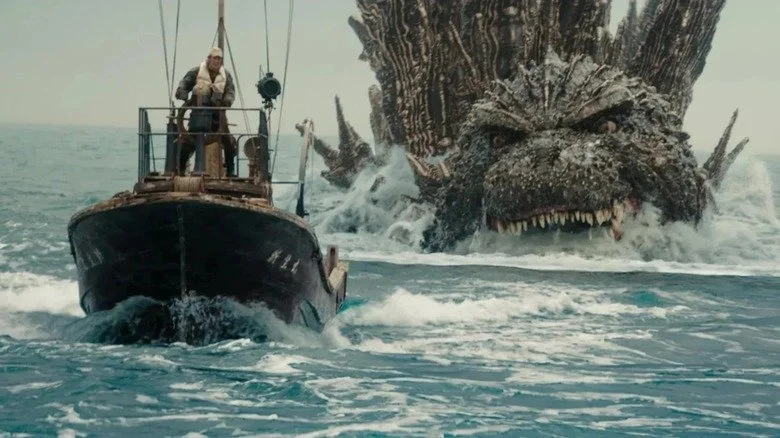Godzilla Minus One Movie Review - Viva La Godzilla
When producing movies for the most recognized kaiju in cinematic history, western studios—in particular—have struggled for years with Godzilla. In 1998, Roland Emmerich’s (Independence Day) depiction was a monster-sized disaster and it wasn’t until sixteen years later when the iconic monster franchise was resurrected onto nationwide cineplexes with Gareth Edward’s (The Creator, Rogue One: A Star Wars Story) 2014 version. Godzilla (2014) was a massive hit for the box-office, but has split the fanbase down the middle. Some praising the reboot for its monster showdowns harkening back to earlier Godzilla installments, visual and performances, while others criticized its bland human characters and the story following their perspectives as it goes along, while missing opportunities with other stronger characters (one of them played by Bryan Cranston) in the process.
Every problem that 2014’s reboot had, its disappointing sequel, “Godzilla: King of the Monsters”, magnified and was excoriated for its even worse script and even worse characters. For all of the eight minutes of Godzilla fighting King Ghidorah, there wasn’t much else to overshadow the film’s inefficient world-building and structure.
However, Godzilla wasn’t originally depicted as a universe-saving mutated lizard who saved the day from unimaginable threats as the series displayed down the road. If the original 1954 Japanese monster film Gojira showed us is that Godzilla’s true roots was to serve as a frightening metaphor for nuclear warfare and the bombing of Hiroshima and Nagasaki in World War II. Japanese film studio, Toto Pictures, has had its go with producing its own modern Godzilla films in the past like 2016’s Shin Godzilla. It’s now the year 2023, and Studio Toho is taking another crack with Godzilla Minus One making it the 37th film.
Before watching the film, the amount of hype, anticipation and critical praise surrounding this film was unbelievable. However, with myself being burnt out by mediocre Godzilla movies by Warner Bros., I was hesitant, but persisted to see it anyway. After getting out of the theaters, here’s the honest-to-God truth: Godzilla Minus One is exactly the reason American studios should just hand over the rights to the Japanese immediately, because they aren’t capable of making something as monumental and euphoric as this. Minus One is the best modern monster movie in recent memory and there isn’t any other than comes close to it. Everything that old school Godzilla fans have been dreaming of came to fruition and then some.
Minus One is set at the closing days of World War II; the Japanese have surrendered and have suffered much devastation in the aftermath. The situation becomes more harrowing and dire for Japan when the Godzilla rolls into the fray devastating cities and vanquishing Japaneses armies and naval forces. With Godzilla making his moves to Tokyo, the world’s hands are left to scientists, former-solders and a traumatized former-kamikaze pilot, Kōichi Shikishima to finish the giant mutated lizard off.
Something that shares in common with the 2014’s reboot is that Minus One carries a lot of inspiration from Spielberg’s “Jaws”, putting itself in the perspective of human characters to latch onto that are trying to figure out how to prevent further damage from Godzilla when taking downtime from the mayhem and destruction. This is where the latest Warner Bros. Godzilla films had difficulty overcoming, but Studio Toho shows exactly that you can make endearing and compelling characters for a monster movie. Nearly every character is intelligently performed, dimensional, and has their moment to shine throughout the course of the film.
There are too many examples to choose from to explain my point, but why don’t we touch on the main character for starters. Ryunosuke Kamiki is absolutely powerful in his performance, gripping you in every scene in times of sorrow, triumph and to the extent of nearly bringing yo to tears. But the writing also showcases how terrific a character Shikishima is; a soldier that carries PTSD of the war, struggling to fulfill his duty and honor to his country and family and finding redemption in his supportive friendship with a woman named Noriko (Manami Hamabe) raising an orphaned child and helping his minesweeping crew-mates hatch a plan to destroy Godzilla and save the entire world.
Speaking of which, let’s talk about the title monster himself. Godzilla is bigger, badder and even more terrifying than ever. With the $15 million applied, it is impeccable what Studio Toho is able to do to capture the might and ferocity of the creature; incredible textures, a fearsome design and precise details on him that are lifted from the original Godzilla pictures, and with his ginormous scale, it also cannot be dismissed Minus One unleashes the most horrifying atomic breath ever captured in Godzilla’s history.
For how jaw-dropping the monster is along with his suspenseful set-pieces, it equally applies to the cinematography by Kōzō Shibasaki. Every close-up capturing the horror of the citizens and Shikishima trying to overcome survivor’s guilt and his psychological demons is matched perfectly with staggering wide shots of Godzilla roaring to the sky after annihilating a populated Japanese district. Minus One’s musical score, even when it throws in suitable inserts of the iconic theme towards the second and third act, raises goosebumps and fits the established tone every step of the way.
Godzilla: Minus One is one of the best movies of the year, and so far the best monster movie of the decade. A staggering achievement unveiling a significant theme of redemption, forgiveness and humanity uniting and banding together when hope becomes out of reach from an apocalyptic force of destruction. If Warner Bros desires to keep the MonsterVerse successful, then they should either take notes from this near masterpiece or should just give it up to the ones who have the experience and move onto another franchise to profit off of.
Minus One towers over all.
RATING: 4.5/5



